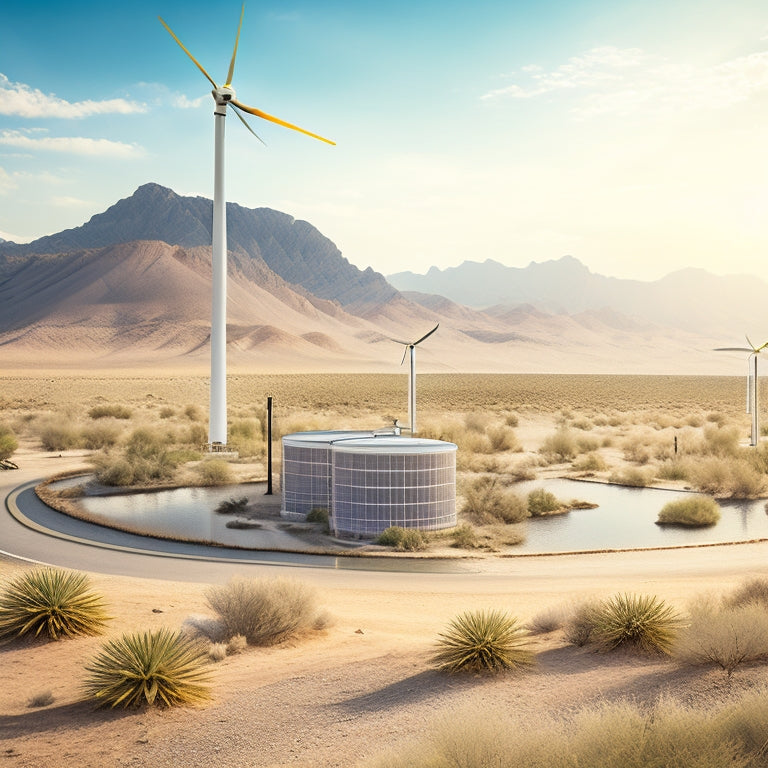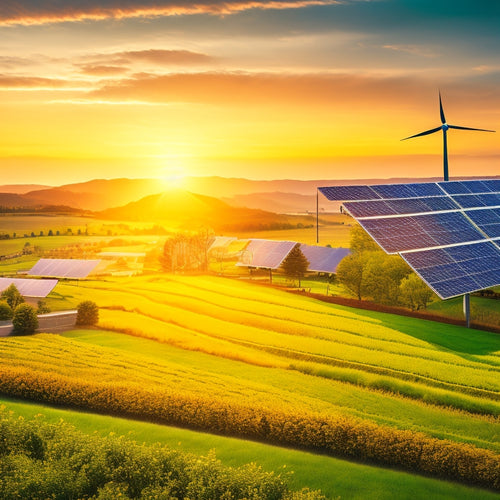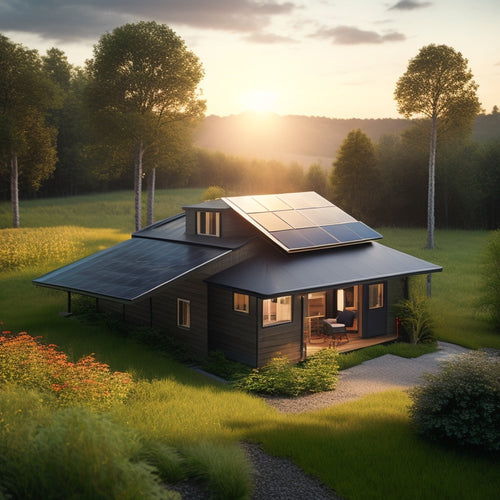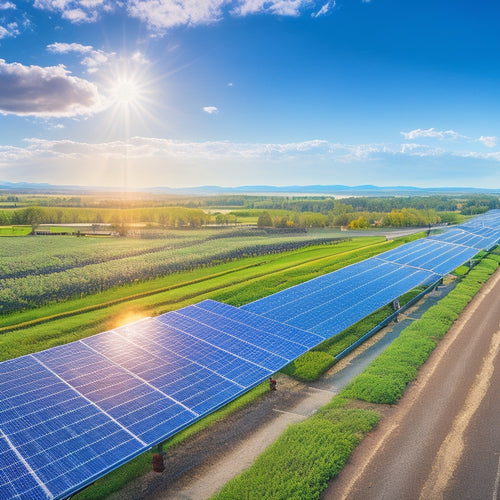
Boost Emergency Water Supply With Renewable Power
Share
You can considerably enhance your emergency water supply by leveraging renewable power sources, particularly solar energy. By evaluating solar energy availability and utilizing innovative pumping systems, you can reduce fossil fuel reliance and guarantee a reliable water supply. With solar-powered pumps, you'll achieve zero emissions, long-term savings, and improved water quality. To optimize your system, consider efficient solar panels, scalable system design, and effective water storage solutions. By integrating renewable power sources and implementing cost-effective solutions, you'll amplify your emergency water supply and enjoy increased independence from public utilities - and that's just the beginning of what's possible.
Overview
- Harness solar energy to power water pumps, reducing reliance on fossil fuels and ensuring a reliable water supply during emergencies.
- Leverage government incentives, like tax credits and rebates, to adopt renewable energy solutions for emergency water supply systems.
- Design scalable systems that integrate renewable power sources, such as solar and wind energy, to ensure seamless operation during outages.
- Implement rainwater harvesting and underground cisterns to store water for emergency use, reducing dependence on public utilities.
- Regular maintenance and inspection of renewable energy systems are crucial to ensure efficient operation and minimize downtime during emergencies.
Harnessing Solar Energy Potential
Frequently, when designing an emergency water supply system, utilizing solar energy potential is an essential consideration.
You'll want to assess the amount of solar energy available at your location to determine the feasibility of your system. By leveraging solar energy innovations, you can capitalize on the power of the sun to pump water, reducing your reliance on fossil fuels and increasing your independence.
Governments and organizations often offer solar power incentives, such as tax credits and rebates, to encourage the adoption of renewable energy solutions. Furthermore, solar energy provides reliable water supply and decreases reliance on the grid for rural water pumping systems.
Additionally, solar-powered pumps enhance water quality by ensuring a reliable supply. By taking advantage of these incentives, you can offset the initial investment costs of your solar-powered water supply system and enjoy long-term savings.
Benefits of Off-Grid Water Pumps
With solar energy powering your water supply system, you can now investigate the benefits of off-grid water pumps. By going off-grid, you'll enjoy increased independence from public utilities and reduced reliance on fossil fuels.
This shift towards sustainability benefits the environment, as you'll produce zero emissions and minimize your carbon footprint. When selecting an off-grid water pump, it's crucial to assess pump efficiency and consider factors such as flow rate, pressure, and power consumption to guarantee peak performance.
Additionally, you should prioritize easy maintenance features in pump design to reduce downtime and simplify repairs. Off-grid water pumps also offer a quieter operation, reduced maintenance, and lower operating costs.
Additionally, you'll experience improved water quality, as the system is less prone to contamination. With an off-grid water pump, you'll have a reliable and self-sufficient water supply, securing your freedom from water scarcity and grid outages.
Choosing the Right Solar Panels
You'll need to select solar panels that meet your specific energy requirements, so it's crucial to evaluate panel efficiency ratings, which can vary considerably between manufacturers.
For instance, high-efficiency silicon solar cells can achieve conversion rates over 26% Advanced Energy Solutions, making them suitable for off-grid systems.
Additionally, you'll want to contemplate mounting system options, as the type of mounting system you choose will impact the overall cost and durability of your setup.
Panel Efficiency Ratings
When selecting the right solar panels for your emergency water supply system, panel efficiency ratings are a significant consideration.
You want to maximize energy output while minimizing space and cost. Efficiency ratings vary among solar panel technologies, ranging from 15% to over 22%.
For example, monocrystalline silicon panels tend to be more efficient than polycrystalline silicon panels. Conducting an efficiency comparison among different solar panel technologies is essential.
Look for panels with high efficiency ratings, typically above 18%, to guarantee you're getting the most power per unit area.
Mounting System Options
Most solar panels require a mounting system to secure them to your roof, ground, or tracking system.
You'll need to choose a mounting system that suits your specific needs and installation type. Ground mounted systems offer flexibility regarding panel orientation and tilt, allowing you to optimize energy production.
Rooftop installations, on the other hand, are ideal for smaller systems and can be more cost-effective.
Consider factors like durability, adjustability, and compatibility with your solar panel brand when selecting a mounting system.
Make certain to research and compare different options to guarantee you're getting the best fit for your emergency water supply system.
Battery Compatibility Issues
Pairing the right solar panels with your battery bank is essential to guarantee a seamless and efficient energy supply for your emergency water system.
You'll need to verify compatibility between your solar panels and battery types, as mismatched systems can lead to reduced performance or even system failure.
Different battery types, such as lead-acid, lithium-ion, or saltwater batteries, have unique charging cycles and requirements. For instance, lithium-ion batteries have a higher voltage tolerance than lead-acid batteries, so you'll need to choose solar panels that can accommodate this difference.
System Design for Emergency Use
Your emergency water supply system requires a thoughtful design to guarantee reliable operation during critical situations.
You'll want to prioritize system scalability to make certain it can adapt to changing needs and circumstances.
As you design your system, consider the specific demands of emergency preparedness, such as surge capacity and backup power sources.
A well-designed system should be able to seamlessly integrate with your renewable power source, providing a reliable flow of clean water even when the grid is down.
Water Storage for Emergency Supply
As you guarantee your emergency water supply system can adapt to changing needs, you'll also want to focus on storing water safely and efficiently. This is where rainwater harvesting and underground cisterns come in.
| Storage Option | Description |
| Rainwater Harvesting | Collects and stores rainwater from rooftops for non-potable uses |
| Underground Cisterns | Buried tanks that store potable water for emergency use |
| Above-Ground Tanks | Visible containers that store water for emergency use |
| Combination Systems | Hybrid systems that combine rainwater harvesting and underground cisterns |
Installation and Maintenance Tips
During the installation of your emergency water supply system, it's essential to take into account factors such as site selection, material durability, and integration with existing infrastructure to guarantee a seamless and efficient setup.
You'll want to employ advanced installation techniques that make certain your system is scalable, adaptable, and resilient.
When it comes to maintenance, establishing a regular schedule is imperative. You should plan to inspect and test your system quarterly, performing tasks such as filter cleaning and component replacement as needed.
Cost-Effective Renewable Solutions
Its renewable power component is essential to the overall efficiency of your emergency water supply system, and selecting cost-effective solutions can greatly reduce operating expenses.
You'll want to contemplate biogas generation, which involves utilizing energy from organic waste. This approach can be particularly effective for rural or off-grid locations where traditional fuel sources may be scarce.
Another option is wind energy, which has become increasingly affordable in recent years. By capitalizing on wind power, you can considerably reduce your reliance on fossil fuels and lower your energy costs.
Frequently Asked Questions
Are Solar-Powered Water Pumps Suitable for Areas With Low Sunlight?
You'll find that solar-powered water pumps can still work in areas with low sunlight, but their solar efficiency is reduced, impacting pump performance; however, choosing a high-efficiency pump and optimizing system design can help mitigate this effect.
Can I Use a Single Solar Panel for Multiple Water Pumps?
You can't use a single solar panel for multiple water pumps, as it'd compromise solar panel efficiency; instead, guarantee pump compatibility by sizing the panel to each pump's specific requirements, guaranteeing ideal energy utilization.
How Do I Determine the Right Water Storage Tank Size for My System?
You'll determine the right water storage tank size by calculating your storage requirements based on factors like daily water demand, rainfall patterns, and pump flow rate, ensuring your tank capacity meets your needs without wasteful overflow.
Are There Any Government Incentives for Renewable Energy Water Systems?
As you traverse the renewable energy environment, you'll uncover a wealth of federal incentives and state programs that can greatly offset your system's cost, giving you the freedom to utilize nature's power without breaking the bank.
Can I Integrate My Solar-Powered Water Pump With an Existing Grid?
You can integrate your solar-powered water pump with an existing grid, guaranteeing solar panel integration and grid compatibility; check the inverter's compatibility with the grid frequency and voltage to ascertain a seamless connection.
Ready to Buy
Enhancing your emergency water supply with renewable power can be a significant improvement in crisis situations. Did you know that a typical American uses around 80-100 gallons of water per day? By utilizing solar energy to power your water pumps, you can reduce your reliance on grid electricity and guarantee a steady supply of clean water when you need it most. With the right system design and installation, you can be confident that your emergency water supply will be there when disaster strikes.
Related Posts
-

Net Metering in Renewable Energy's Future
Net metering's future is vital for driving renewable energy growth and financial savings. You can reduce your electri...
-

Diy Off Grid Solar
By embracing DIY off-grid solar, you can break free from grid dependence, slashing your energy bills by up to 90% and...
-

Applications of Photovoltaic Systems
Photovoltaic systems are versatile, converting sunlight into electricity for various applications. You can use them i...


